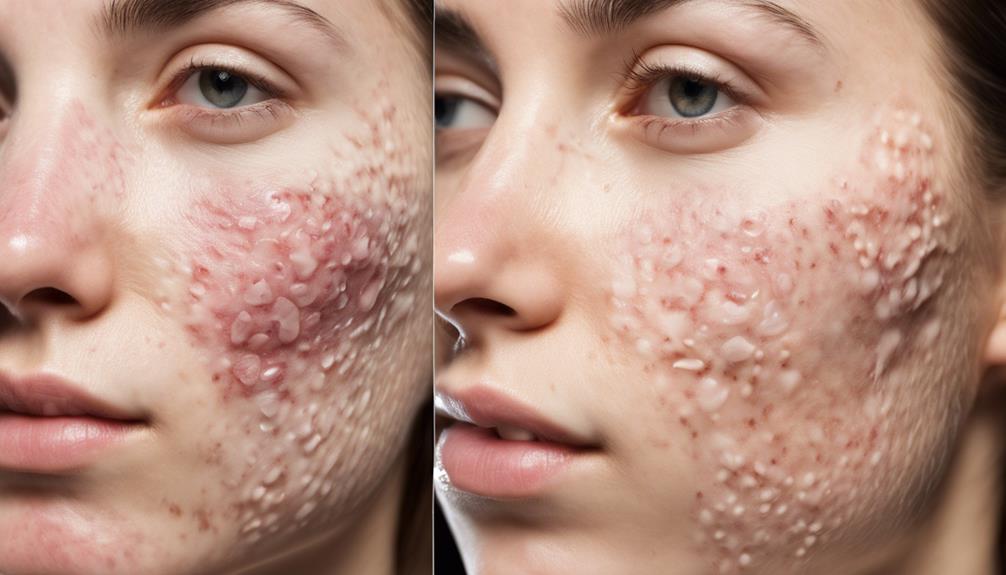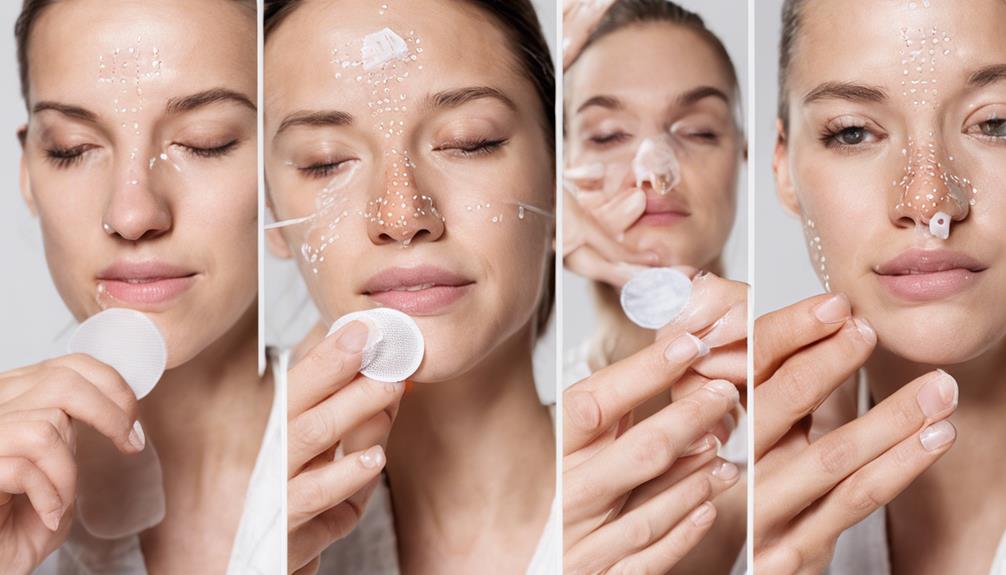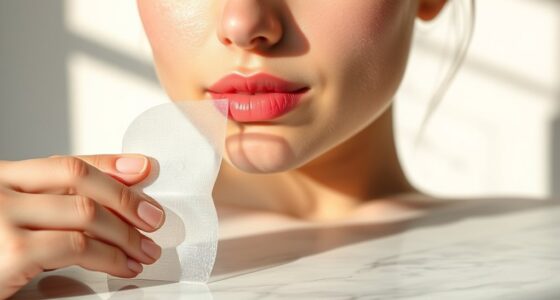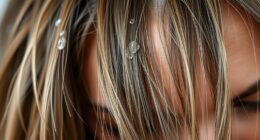Pimple patches are effective at targeting individual breakouts. They are made of hydrocolloid, which absorbs fluids from the pimple, prevents touching, and fosters a moist environment for quick healing. These patches work by absorbing oil and pus, forming a protective barrier, and reducing inflammation to prevent scarring. Active ingredients like salicylic acid and benzoyl peroxide enhance their efficacy. Remember to apply them on clean, dry skin, and replace promptly if they fall off. Potential side effects include skin dryness and rare allergic reactions. Consider the type and severity of acne for varied effectiveness. Learn more about their benefits and usage.
Key Takeaways
- Absorb excess oil and pus, promoting faster healing.
- Create a protective barrier to prevent picking and touching.
- Maintain a moist environment for quicker recovery.
- Reduce inflammation and prevent scarring.
- Facilitate the acne drying process effectively.
Benefits of Using Pimple Patches
Using pimple patches offers a convenient and effective way to target and treat individual breakouts quickly. These patches, made of hydrocolloid, work wonders by absorbing fluids from the pimple, preventing you from picking or touching it, and creating a moist environment for fast healing. The spot treatment that pimple patches provide is unparalleled. They're like little healers that sit on your skin, working their magic while you go about your day or sleep peacefully at night.
The beauty of pimple patches lies in their ability to provide focused care right where you need it. By keeping the area covered and protected, they promote rapid healing, sometimes even making pesky pimples vanish overnight. Their waterproof nature guarantees you can wear them anytime, anywhere, without worrying about them coming off.
How Pimple Patches Heal Acne
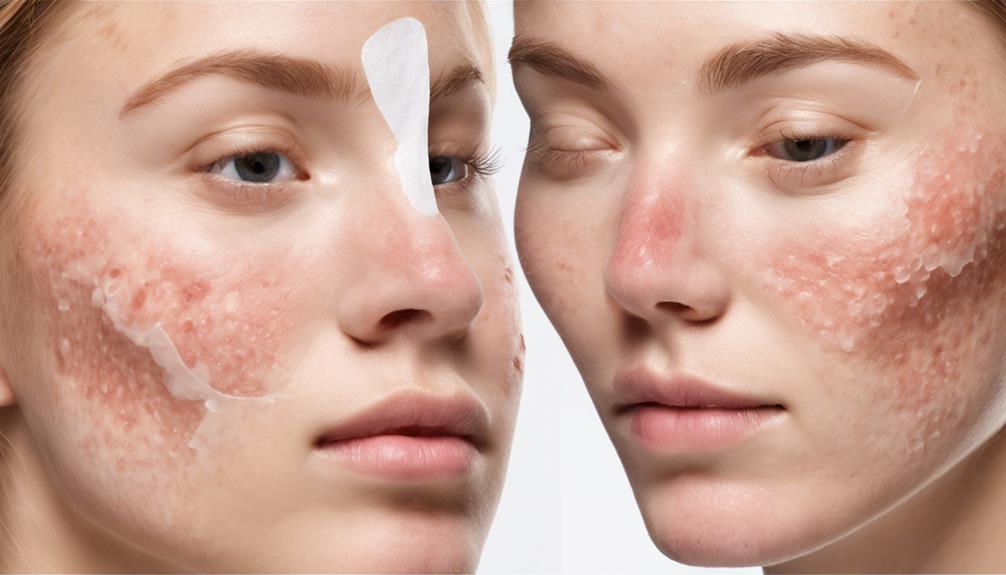
Pimple patches work by absorbing excess oil and pus from pimples, creating a protective barrier to shield them from external irritants, and maintaining a moist environment for faster healing.
They aid in reducing inflammation and preventing scarring, thanks to the hydrocolloid technology that helps dry out pimples and promote skin recovery.
These patches effectively facilitate the acne drying process and offer a reliable method for protecting blemishes.
Acne Drying Process
Employing hydrocolloid technology in pimple patches accelerates the acne drying process, aiding in faster healing and reduced inflammation. Here's how pimple patches help dry out pimples effectively:
- Absorption of Fluids: The hydrocolloid in pimple patches absorbs fluids, toxins, and pus from acne, promoting faster healing.
- Promotes Healing: By creating a moist environment conducive to healing, pimple patches prevent scarring by acting as a barrier against external factors.
- Reduces Inflammation: Hydrocolloid technology aids in drying out pimples, reducing inflammation, redness, and oiliness.
- Antibacterial Properties: Patches with antibacterial properties facilitate quick healing of acne lesions, making them effective for mild to moderate acne.
Blemish Protection Method
Accelerating the drying process of acne, pimple patches with hydrocolloid technology form a protective barrier over blemishes, aiding in faster healing and reducing inflammation. These patches, made of hydrocolloid gel, absorb fluids from pimples, creating a barrier that prevents picking and trauma, promoting a moist environment for recovery. They're most effective on open, draining, and healing pustules, papules, and cysts.
Designed to assist in healing if skin is picked or zits are popped, they help reduce inflammation and promote recovery. Upon removal, smaller, less inflamed blemishes are often observed, indicating progress in healing. Pimple patches serve as a valuable tool in blemish protection, supporting the skin's natural healing process.
The Science Behind Pimple Patches
Utilizing hydrocolloid technology, pimple patches create a conducive environment for accelerated wound healing by absorbing fluids from pimples and promoting skin repair. Here's how they work:
- Absorbs Fluids: The hydrocolloid material in pimple patches draws out the pus and excess fluids from the pimple, helping to flatten it faster.
- Promotes Healing: By maintaining a moist environment, these patches support the skin's natural healing process, reducing the time it takes for a pimple to heal.
- Prevents Picking: Acting as a physical barrier, pimple patches deter you from picking or touching the pimple, which can lead to scarring and further infection.
- Effective on Open Pimples: Pimple patches are particularly beneficial for open or draining pimples, such as pustules, papules, and cysts, aiding in the recovery of damaged skin.
Understanding the science behind pimple patches allows you to make an informed decision on how to best utilize them in your skincare routine.
Key Ingredients in Pimple Patches
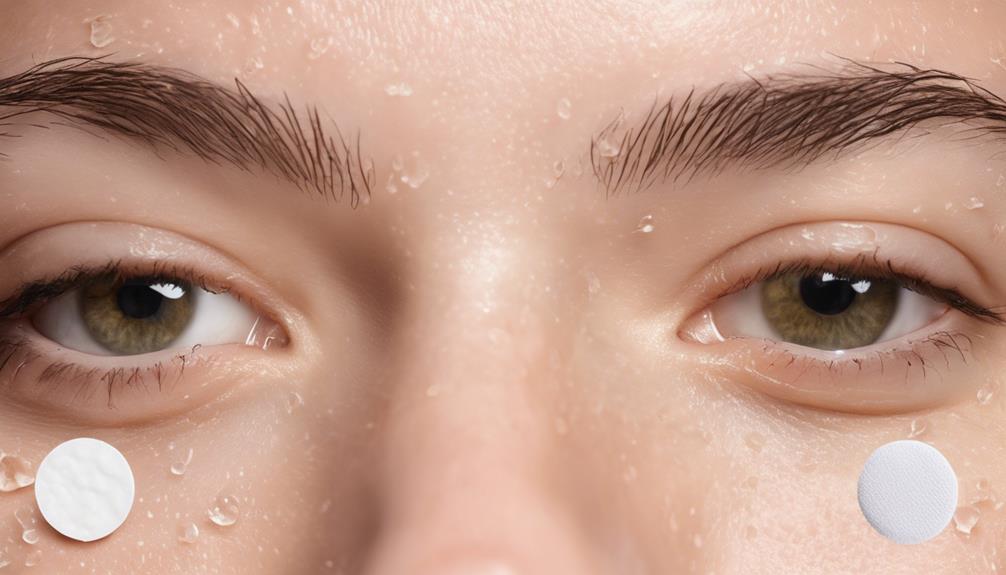
Pimple patches typically contain active ingredients like salicylic acid and benzoyl peroxide, which work to target bacteria, inflammation, and pore-clogging. These key ingredients provide skin benefits by helping to improve acne and promote clearer skin.
When selecting a pimple patch, consider the active ingredients to make sure you're getting the right treatment for your skin concerns.
Active Ingredients
Key ingredients found in pimple patches, such as salicylic acid and benzoyl peroxide, are renowned for their effective acne-fighting properties. When applied to the skin, these active ingredients work to unclog pores, reduce inflammation, and combat acne-causing bacteria.
For best results, follow these steps when using pimple patches:
- Cleanse: Start with a clean, dry face before applying the patch.
- Apply: Gently place the patch over the affected area.
- Leave on: Allow the patch to work its magic for the recommended time.
- Replace: Change the patch as needed to maintain effectiveness.
Skin Benefits
With ingredients like salicylic acid, benzoyl peroxide, and tea tree oil, pimple patches offer various skin benefits that help combat acne and promote clearer, healthier skin. Salicylic acid helps unclog pores and reduce inflammation, while benzoyl peroxide acts as an antiseptic to fight acne-causing bacteria. Tea tree oil's antibacterial properties also aid in reducing inflammation.
Additionally, the hydrocolloid in pimple patches absorbs excess oil and pus, promoting faster healing. Hyaluronic acid provides hydration to the skin, preventing dryness, and niacinamide improves skin tone and texture, enhancing overall skin health. By incorporating these key ingredients, pimple patches not only target existing pimples but also work to prevent future breakouts and promote a smoother complexion.
Types of Pimple Patches Available
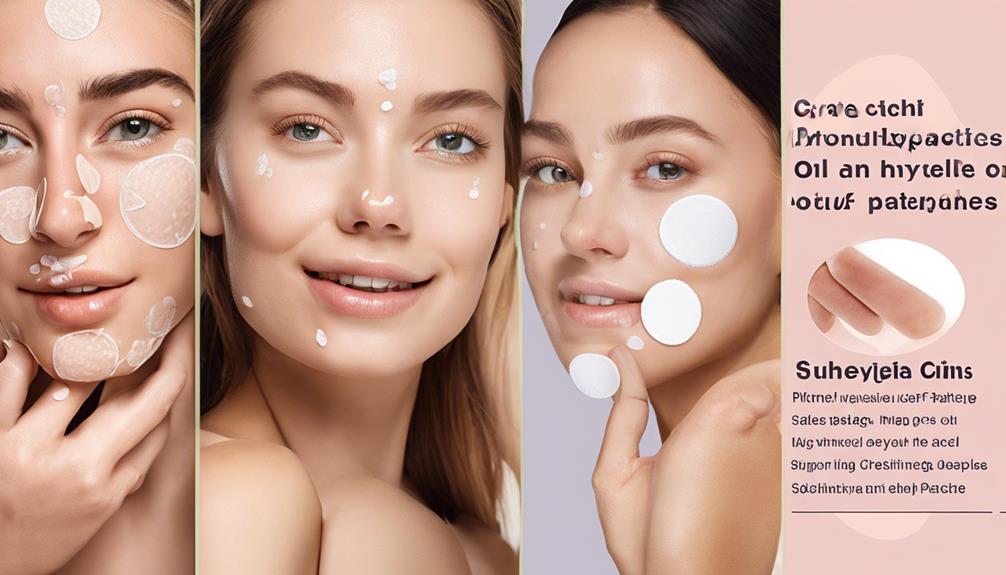
Available in various types, pimple patches cater to different skin concerns and types of acne lesions, providing targeted solutions for effective treatment.
When choosing a pimple patch, consider the following options:
- Hydrocolloid Patch: Ideal for absorbing excess oil and pus from pimples, promoting faster healing and reducing inflammation.
- Medicated Patches: Contain active ingredients like salicylic acid and tea tree oil to target specific skin concerns such as acne-causing bacteria and inflammation.
- Adhesives: Different types like acrylic, silicone, and hydrogel are used to secure the patch in place, ensuring it stays on the pimple for the best treatment.
- Microneedling Patches: Designed for deeper lesions, these patches create micro-channels in the skin to enhance the absorption of active ingredients, accelerating the healing process.
With these options available, you can select the pimple patch that best suits your skin type and acne concerns, helping you achieve clearer, healthier skin effectively.
Tips for Using Pimple Patches Effectively
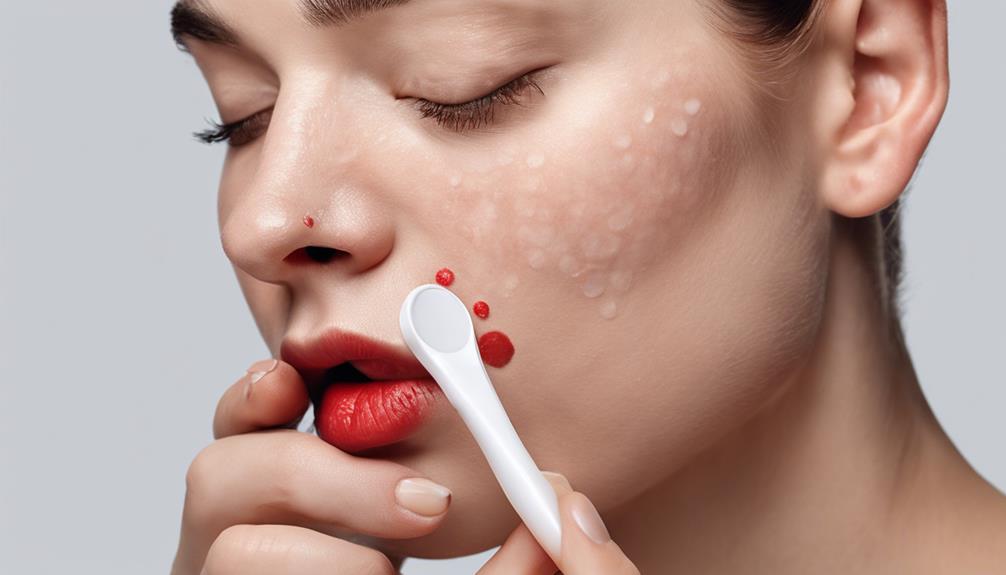
For successful use of pimple patches, always make sure to cleanse and dry the pimple area before application to enhance adhesion and efficacy. This step is vital in preparing your skin for the hydrocolloid patches to work effectively.
By applying the patch directly onto clean, dry skin, you create a barrier that protects your skin from external irritants while helping to heal the pimple underneath. Leaving the patch on for several hours or overnight allows it to absorb fluids and promote healing of the small wound.
Remember, if the patch falls off, replace it promptly to maintain its protective barrier and prevent yourself from picking at the affected area. It's essential to remember that pimple patches are designed for small wounds like pimples and shouldn't be applied on broken skin to avoid any potential irritation.
Common Misconceptions About Pimple Patches
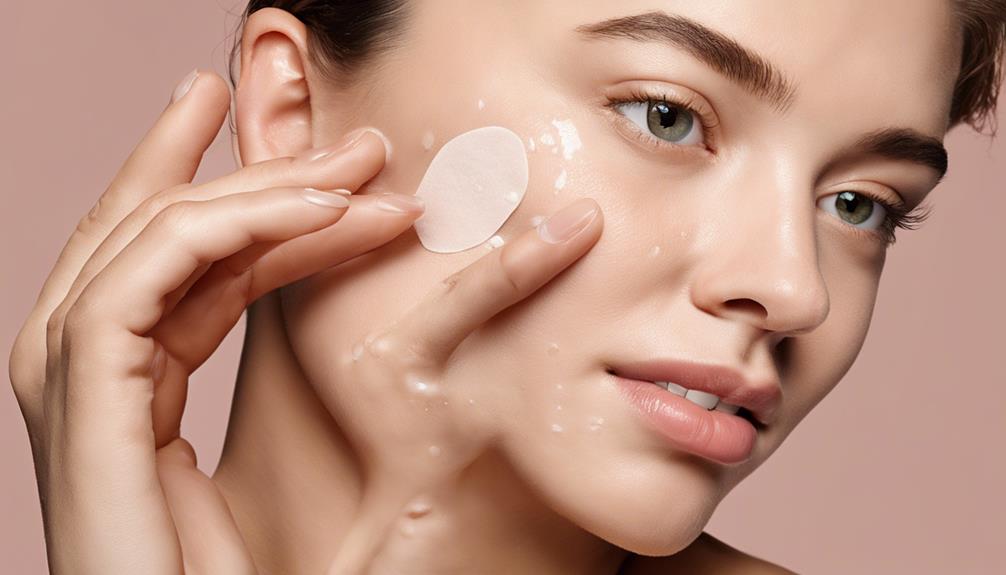
Despite their effectiveness in treating certain types of pimples, common misconceptions about pimple patches can lead to confusion among users. Here are some facts to clarify these misunderstandings:
- Pimple patches are specific wound healing dressings made of hydrocolloid, designed to target small, open wounds caused by pimples. They aren't meant for preventing acne or clearing clogged pores.
- These patches are most effective on open, draining, healing pimples and aren't suitable for closed or deeper lesions. They work by absorbing the fluid from the pimple and creating a barrier against external bacteria.
- While some believe pimple patches can worsen acne, they're generally safe for most users and can be effective for cystic acne treatment.
- Pimple patches have limitations on the types of acne they can effectively treat. Understanding their purpose and using them correctly on the right kind of pimples can enhance their efficacy in promoting quicker healing.
Potential Side Effects of Pimple Patches
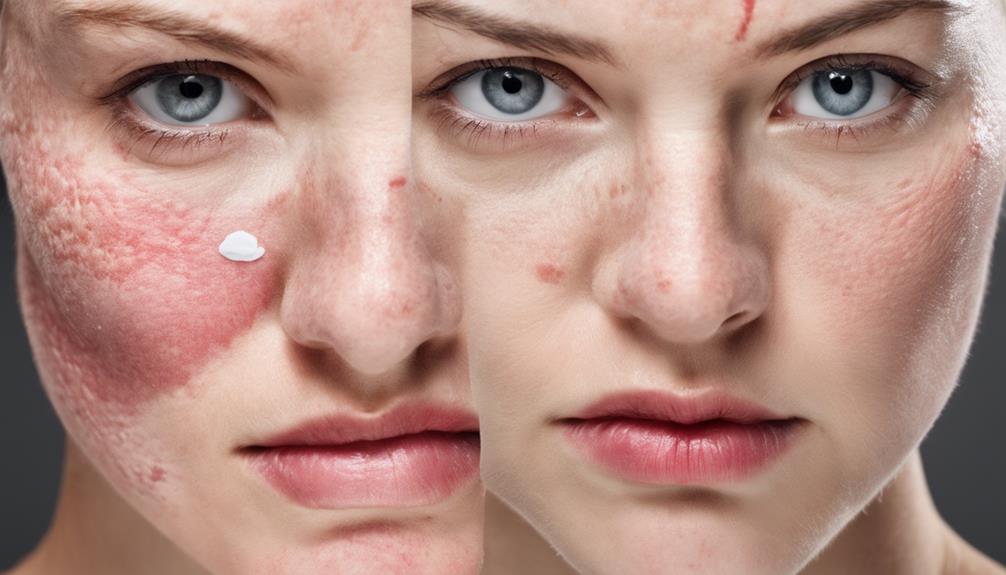
What're the potential side effects of using pimple patches? While Hydrocolloid Acne Patches are generally safe and effective for many, there are some side effects to be aware of. Prolonged use of these patches may lead to skin dryness due to the acidic nature of the patch that helps draw out impurities from the pimple.
Additionally, some individuals may experience irritation from the adhesive used in the patches, causing discomfort. Allergic reactions to the components in the adhesive are rare but possible for some people.
If you notice persistent redness, itching, or any other adverse reactions while using pimple patches, it's essential to consult a dermatologist. A dermatologist can provide guidance on whether the patches are suitable for your skin type and recommend alternative treatments if needed.
Discontinuing the use of pimple patches if you experience ongoing skin irritation is advisable to prevent further discomfort and potential damage to your skin cells.
Comparing Pimple Patches to Other Acne Treatments

When comparing pimple patches to other acne treatments, you may find that their effectiveness varies depending on the type and severity of your acne. Here are some key points to keep in mind:
- Pimple patches target surface-level acne: They work well for pus-filled bumps, blackheads, and whiteheads, providing a protective barrier and promoting faster healing.
- Dermatologist-recommended ingredients: For more severe acne cases, dermatologists advise using treatments with salicylic acid or benzoyl peroxide, as these ingredients help to combat acne at a deeper level.
- Non-medicated options: While pimple patches are effective for daily use, non-medicated versions are preferred by dermatologists to avoid excessive drying or irritation of the skin.
- Consult a dermatologist for severe cystic acne: If you have cystic acne, which often requires more intensive treatment, it's important to seek personalized advice from a dermatologist for the most effective solutions.
Frequently Asked Questions
Do Pimple Patches Actually Work?
Pimple patches can indeed work wonders for your skin. By absorbing fluids and creating a protective barrier, they help speed up the healing process of draining pimples like pustules, papules, and cysts. These little patches can reduce inflammation and promote smaller blemishes when removed.
While not a cure-all for acne, they can be a helpful tool for spot treatment and aiding in the healing of specific types of pimples. Give them a try for targeted skin care support.
Do Pimple Patches Work on Unpopped Pimples?
Pimple patches can effectively work on unpopped pimples by aiding in healing and preventing further irritation. They're designed to target active bumps, such as pustules and papules.
However, they may not be as effective on closed or deeper lesions, blackheads, or whiteheads. For best results, apply pimple patches on open, draining, or healing acne spots to help speed up the recovery process and minimize scarring.
Do Dermatologists Recommend Pimple Patches?
Dermatologists do recommend pimple patches for treating superficial acne like pus-filled bumps, blackheads, and whiteheads. They prefer non-medicated versions for effective acne treatment. Pimple patches work by absorbing toxins with hydrocolloid technology, drying out pimples.
Dermatologists suggest using them as a cover-up to prevent picking and scarring of healing acne, also protecting it from external factors like sunlight. Make sure to follow their advice for the best results.
Is It Better to Use a Pimple Patch or Leave It?
It's better to use a pimple patch than leave it untreated.
Pimple patches absorb fluid, reduce inflammation, and block out dirt and bacteria. They help speed up the healing process and prevent scarring.
By using a pimple patch, you're taking a proactive step to promote faster healing and minimize the risk of making the pimple worse.
Do Pimple Patches Actually Work in Treating Acne?
Yes, the science behind pimple patches is real. These tiny stickers contain active ingredients that penetrate the skin to treat acne. The patch creates a perfect environment for healing and preventing scarring. With consistent use, pimple patches can effectively reduce inflammation and bacteria, resulting in clearer skin.
Conclusion
To sum up, pimple patches are a powerful and practical solution for treating acne. Their ability to heal pimples quickly and effectively makes them a popular choice for many.
By understanding how pimple patches work and following proper usage tips, you can maximize their effectiveness. Remember, consistency is key when using pimple patches to see the best results.
So, don't hesitate to give them a try and say goodbye to stubborn breakouts!
Emma founded Patchology.org with a vision to simplify skincare through the innovative use of patches. With over a decade of experience in skincare blogging, Emma ensures that every piece of content on the site meets the highest standards of clarity and integrity. She loves curating content that makes skincare accessible to everyone.



